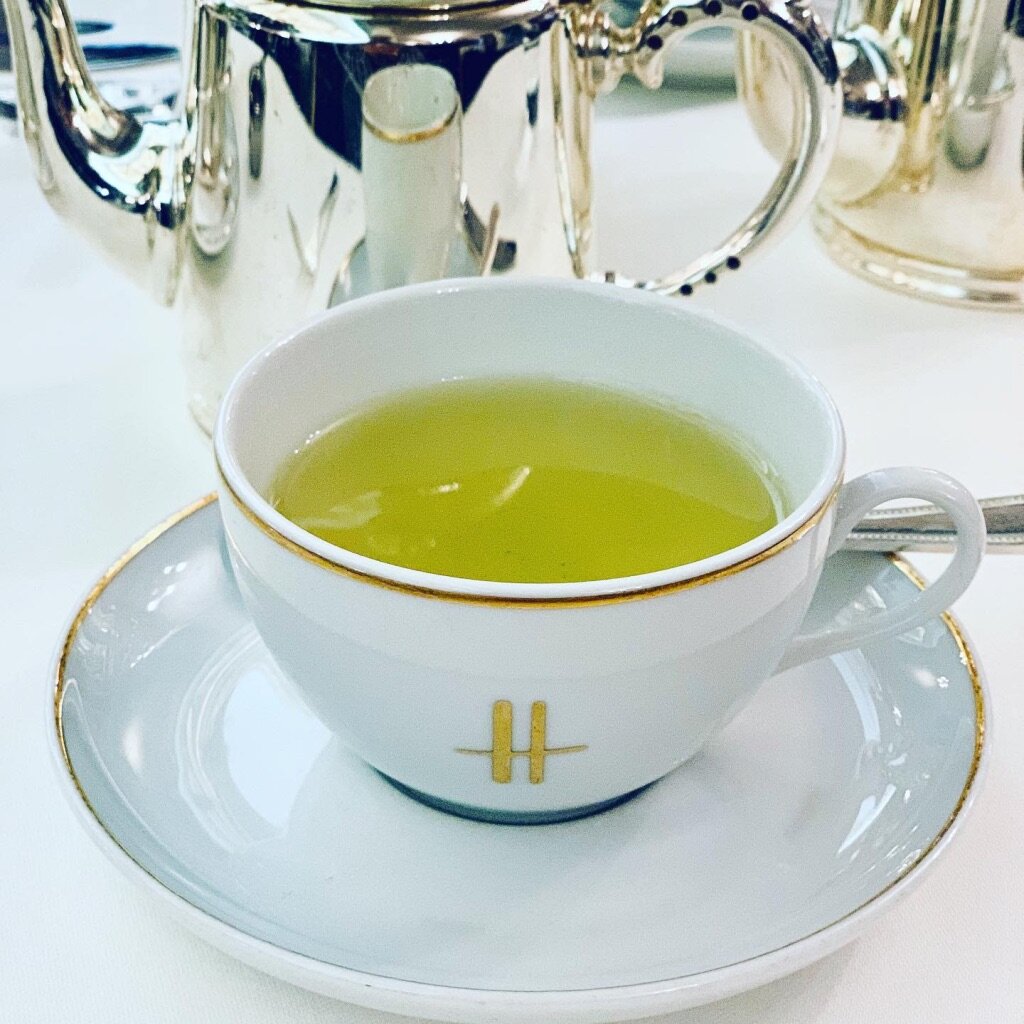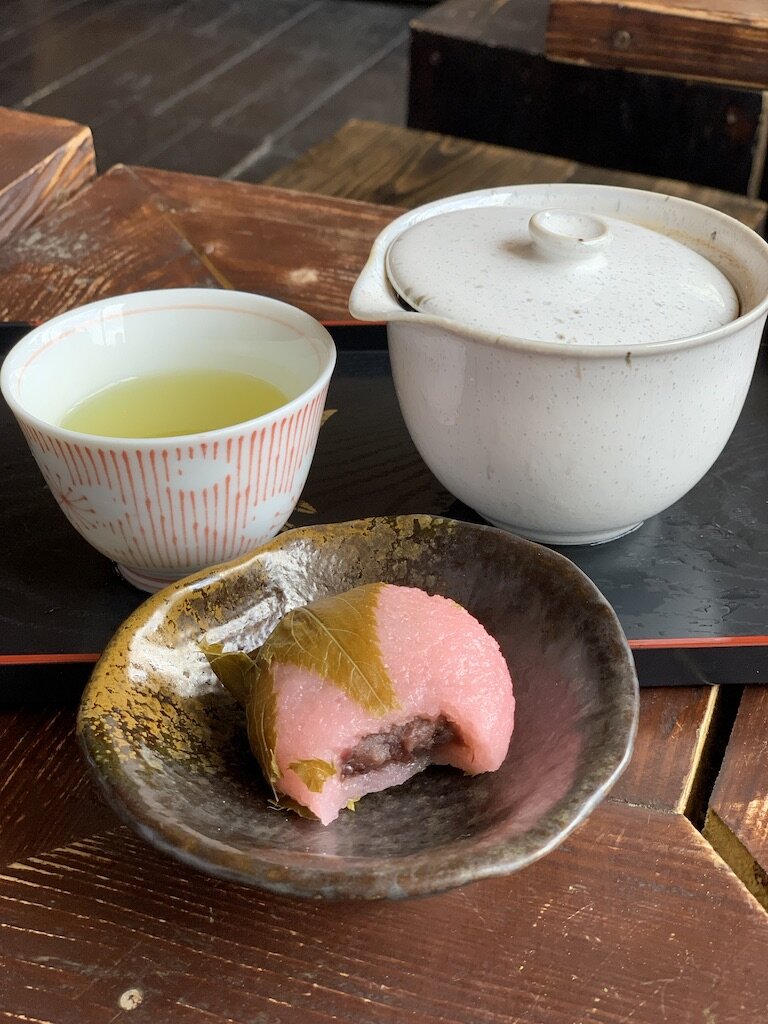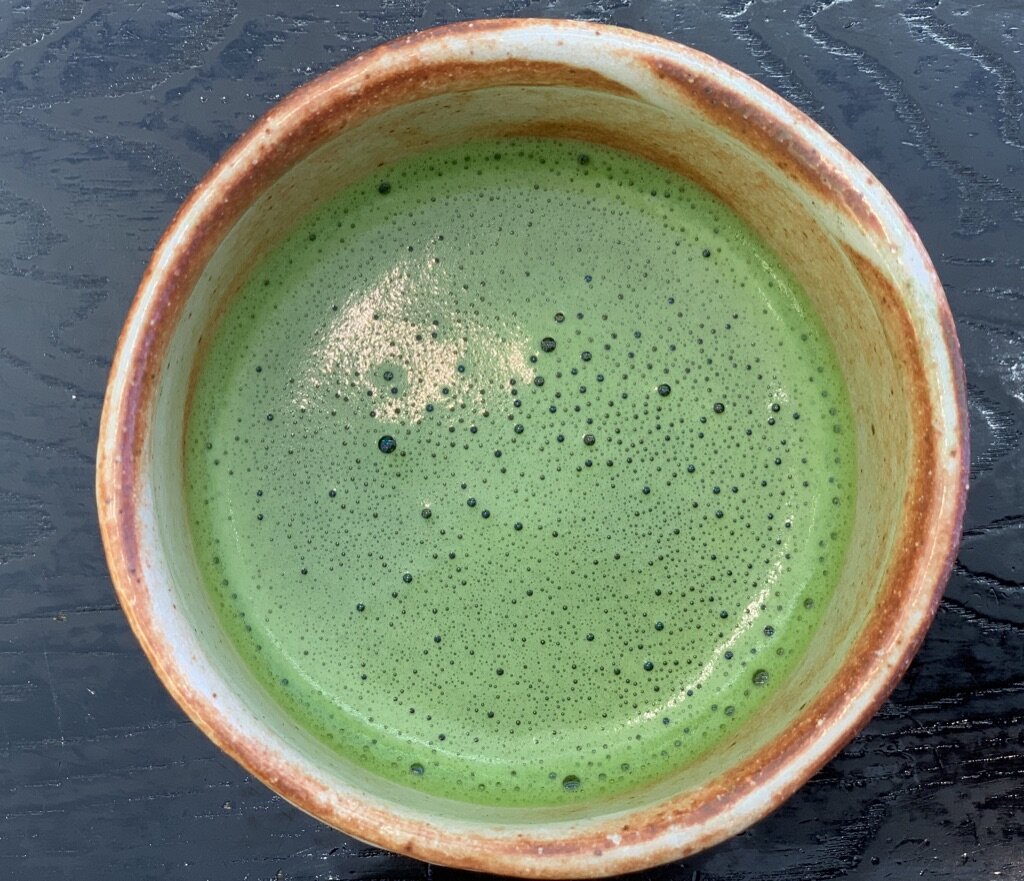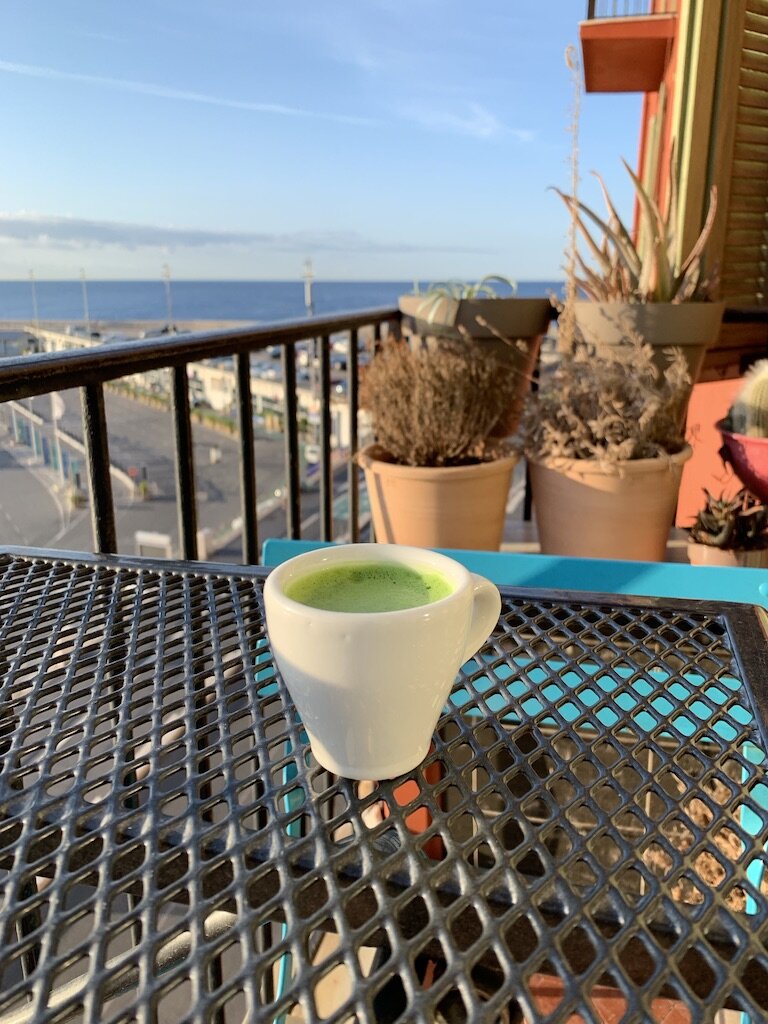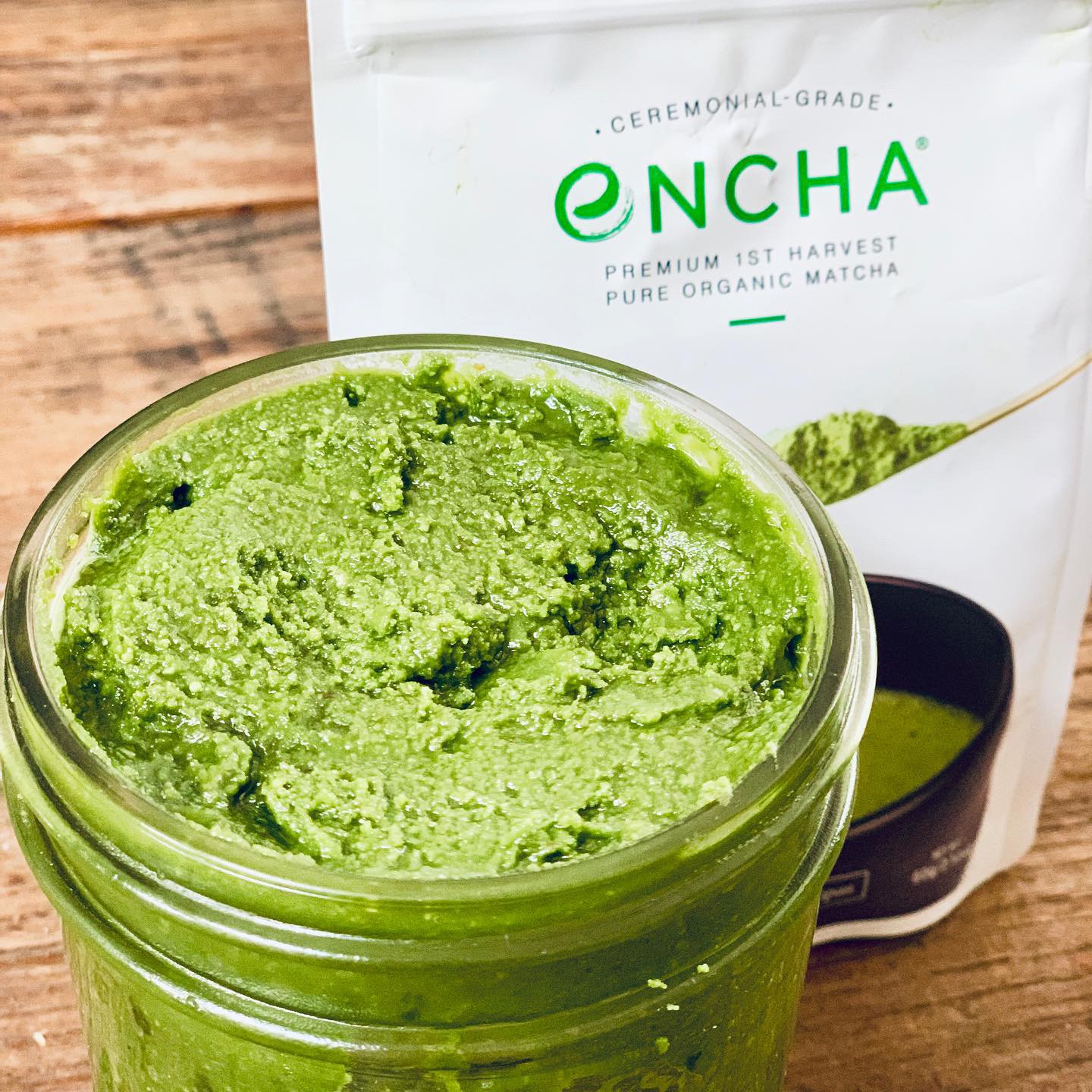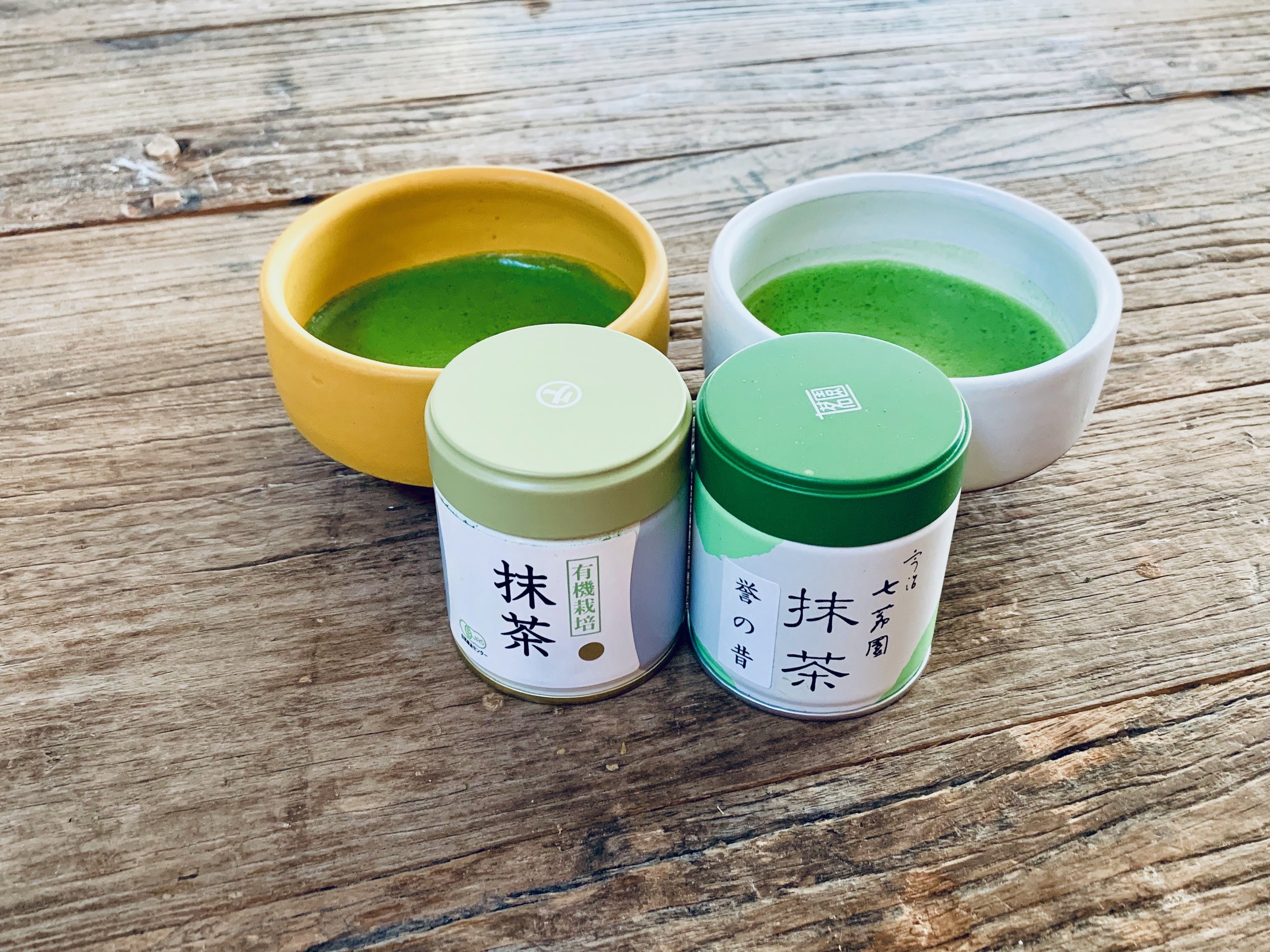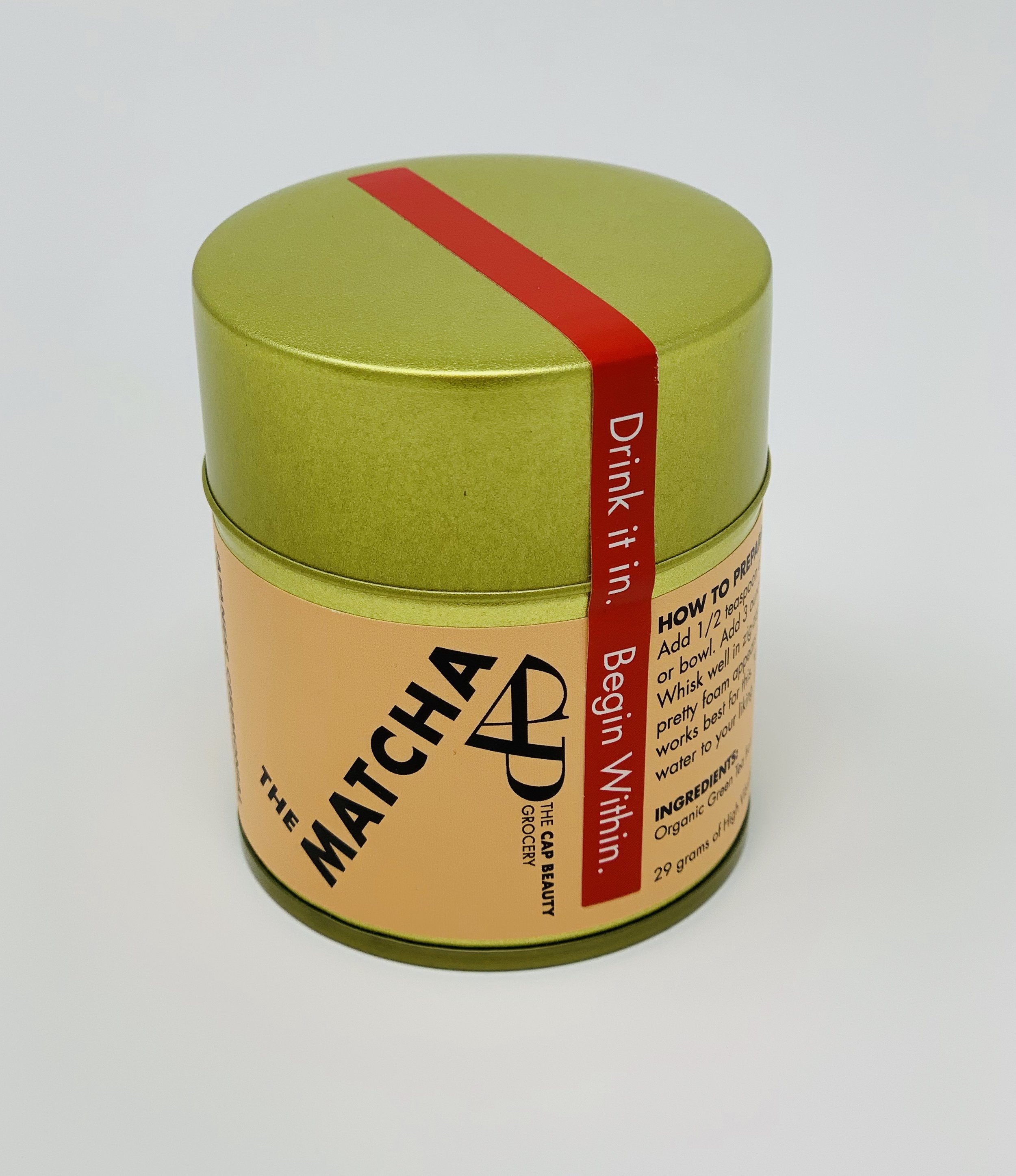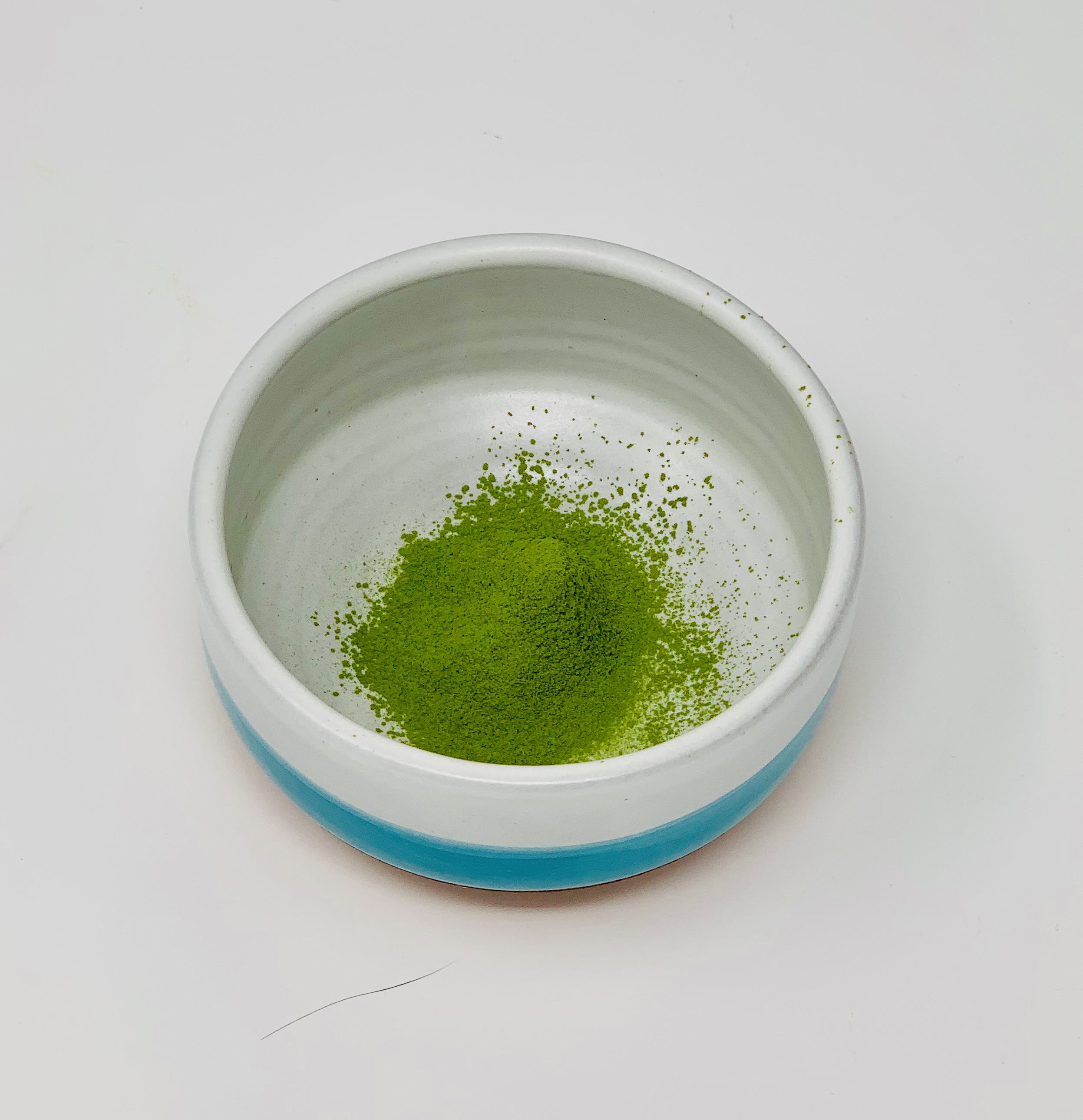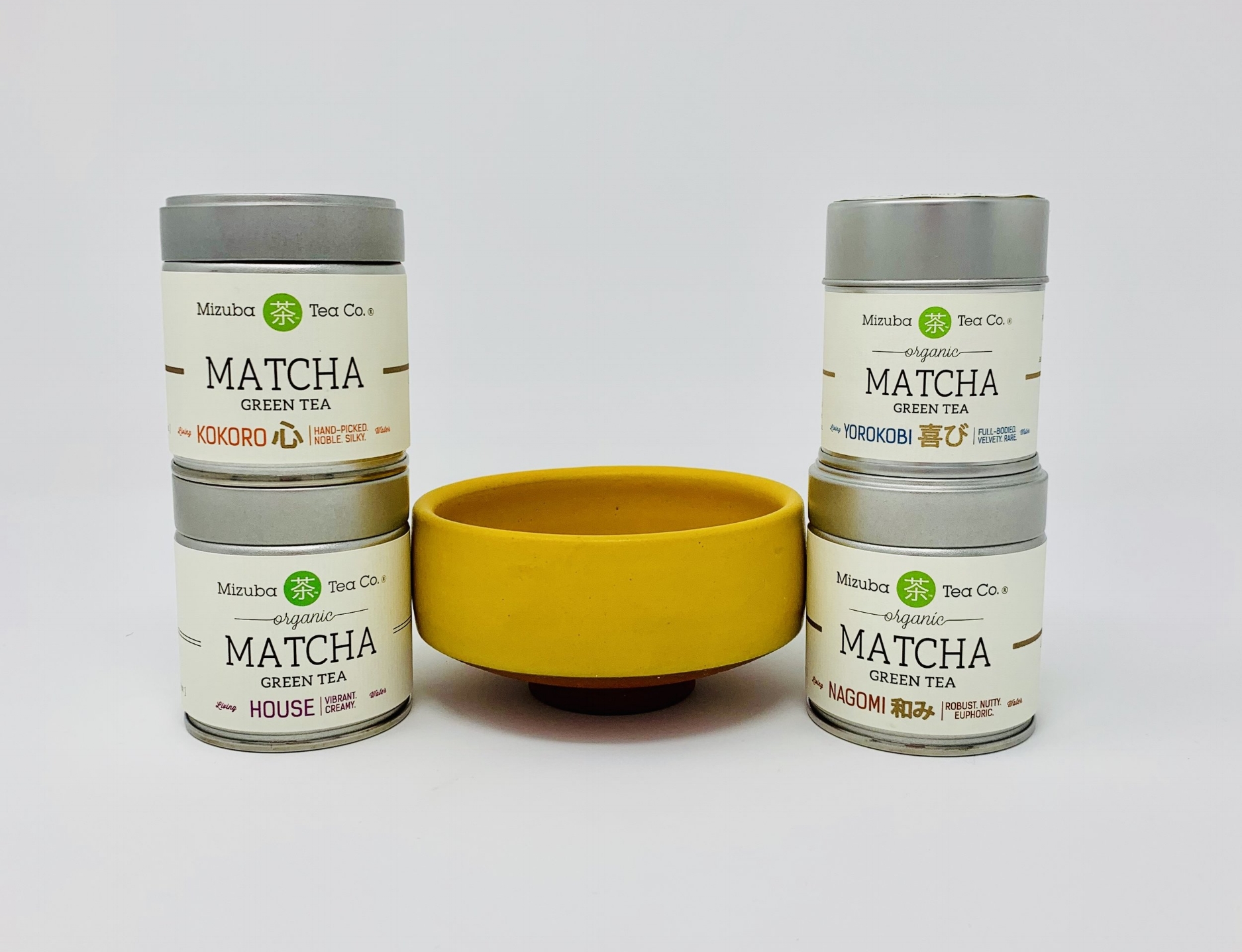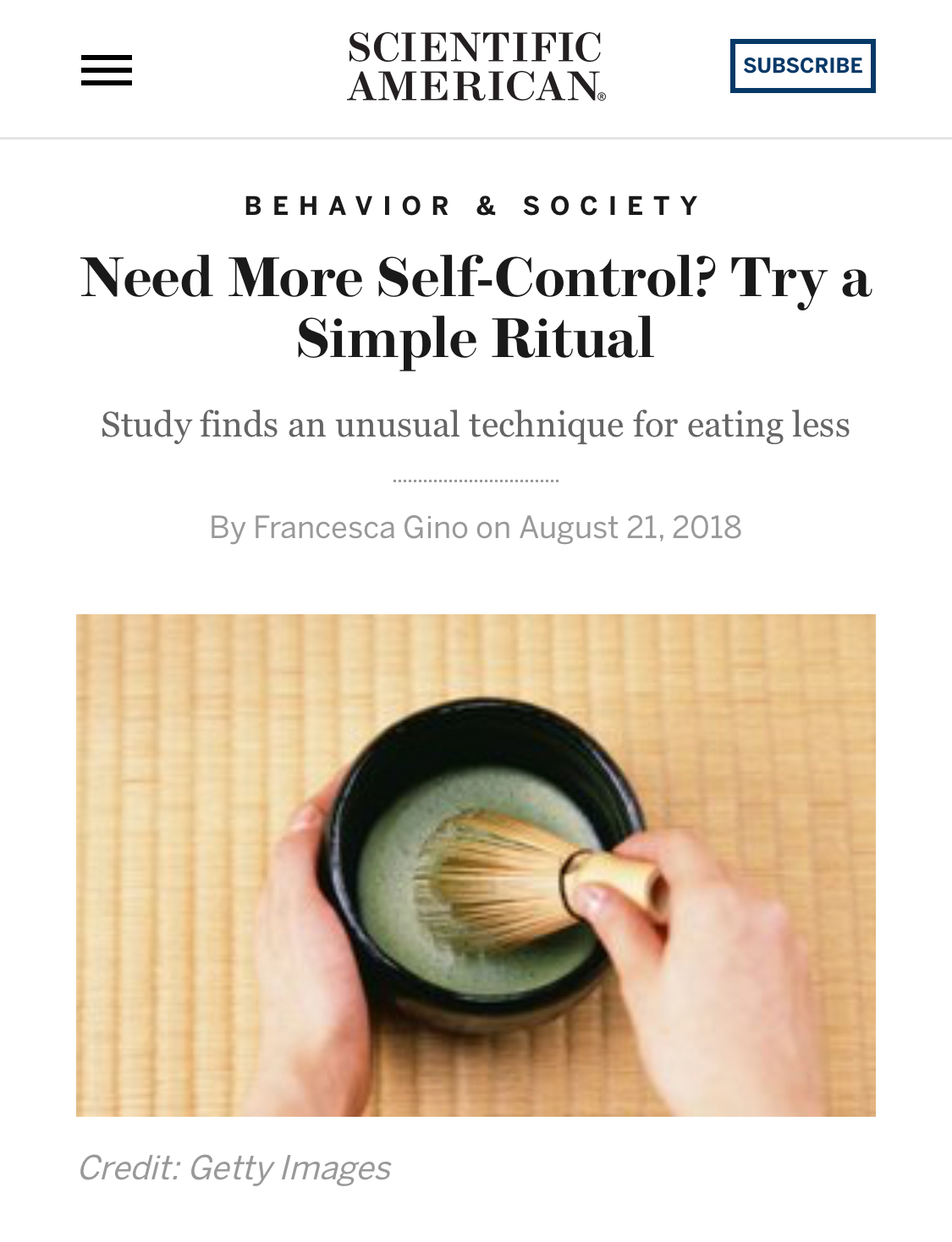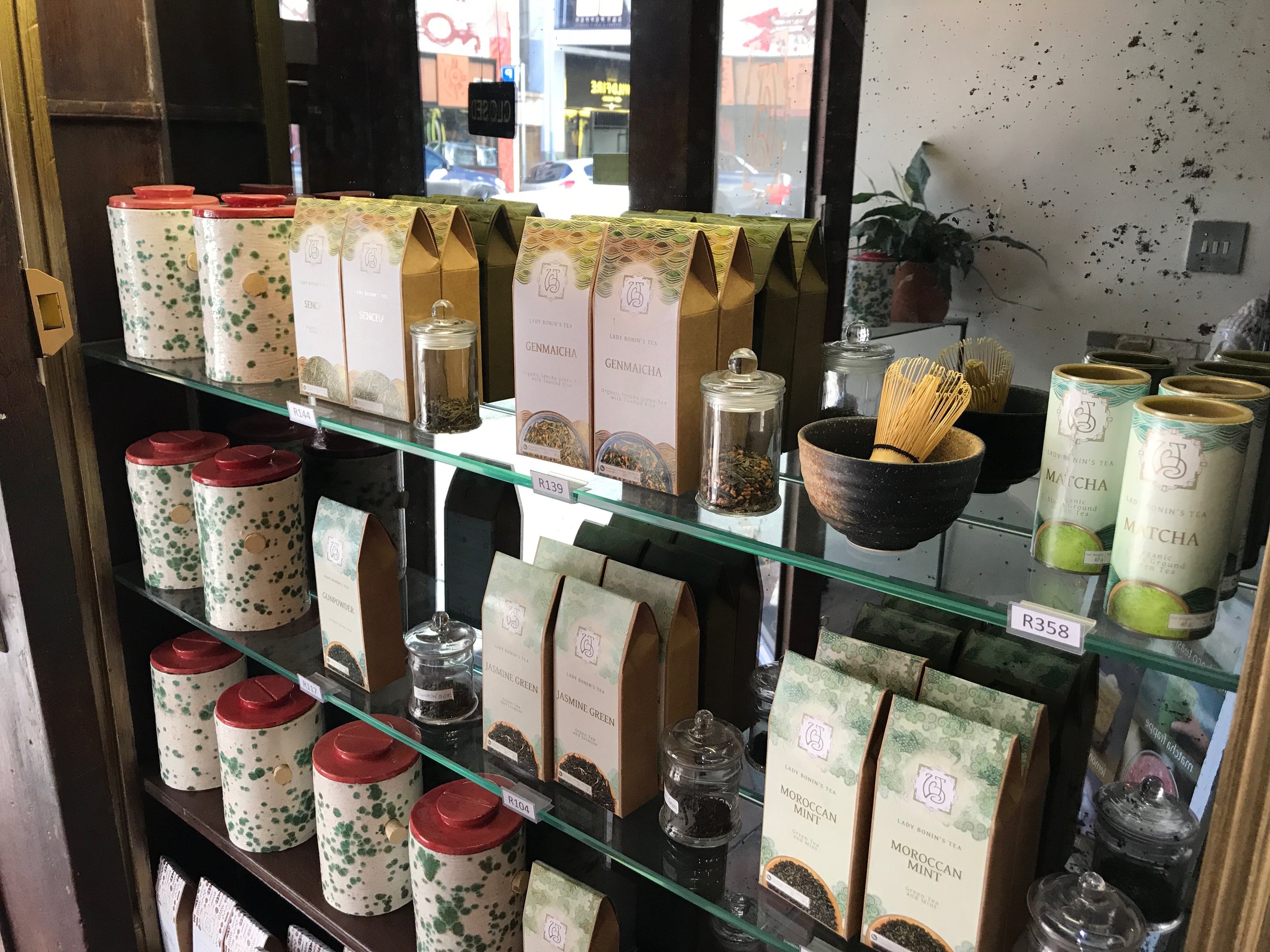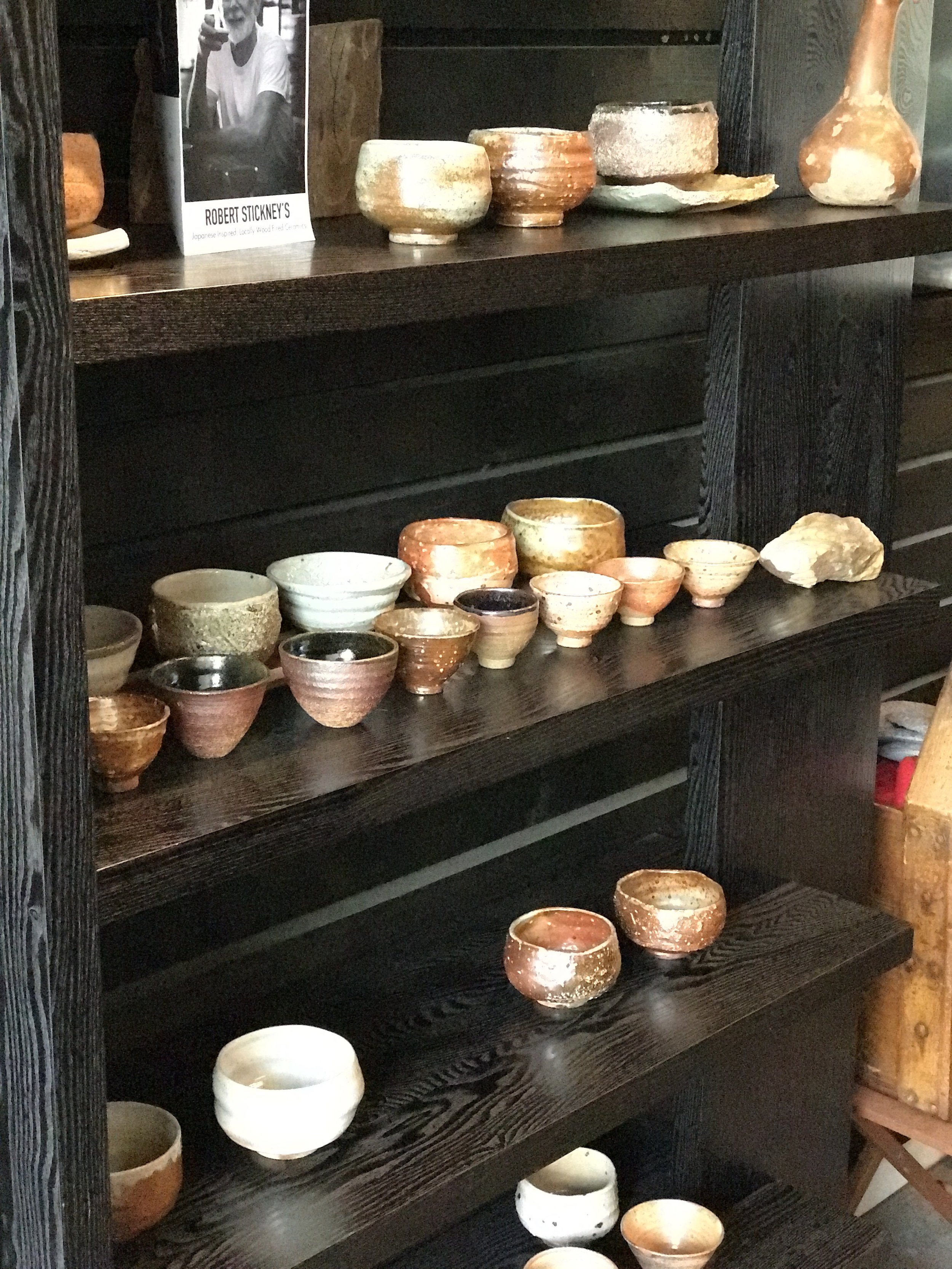
Matcha Travels through London and Nice
This year my trip around the globe took me to London and to Nice! Such an amazing trip, yet a tug of war arises within that leaves me deeply struggling to reconcile the two sides - the one side of me that LOVES travel, seeing new places, experiencing new cultures, discovering new teahouses in which to sip an afternoon away, and the socially, environmentally conscious side that knows I am contributing to climate change no matter how may carbon credits to offset my footprint I purchase. Meditating on my personal and direct impact leaves me questioning and searching.
I was only in London for a few days, so I had to pack as much matcha tasting in as possible, given that I had other plans in the city. Prior to landing, I received only a few suggestions from some of my matcha loving friends on social media of places to visit. London is not the first place you think of visiting for Japanese teas. Had I longed for traditional English high tea, my cup would have runneth over. However, London is the home of one of my first matcha loves - the Matchaeologist. While they do not have a physical store, several of their products are stocked by specialist tea and coffee shops throughout London (like WA Cafe, a small, independent Japanese patisserie making Japanese breads and pastries daily on-site in their Covent Gardens location). Before my departure, I messaged the Matchaeologist and they shared how they often provide free next-day shipping to UK hotels. I was so tempted, but I was already traveling with my stash of their matcha, and I anticipated purchasing new brands during my travels, which I did.
We arrived at 8 AM in Trafalgar Square, dropped off our bags at our hotel, and headed to the TKTS booth to get tickets for a show that evening. Along the way we passed Japan Center and stopped in for a quick matcha latte with soy milk, which was unremarkable, before standing in line. Later that evening, before the show, I stopped into Tsujiri at their Soho location. Sadly I didn’t get to stop at their other location. This storefront lacked the elegance and aesthetic evident in the photos of the their other locations. Most of the patrons that evening were partaking in all the matcha-flavored, dairy delights, but alas, as a dairy-free, gluten-free person, I cannot. However, I was able to get a hardy chawan of matcha and a vegan, Houjicha-flavored dark chocolate bar. I was a tad disappointed, despite it being their higher tier matcha. I find found it a bit flat and bitter with a bit of a stale smell. Still, it was my first official chawan in London. The chocolate bar was fantastic and did not make it until intermission, which was my intention.
Before my spa and massage at the wonderful Corinthia Hotel London, I managed to grab a spot of breakfast accompanied by a very creamy, smooth and delicious, although a tad sweet, almond milk matcha latte. I must say, I fancied the glass cups in which these were served.
Later that evening, we popped over to Harrod’s, mostly to see the whole spectacle of the establishment. The gyokuro I had was a beautiful color, but the temperature of the water was a bit too hot and perhaps steeped a few seconds too long. Still the presentation was lovely, and I thoroughly enjoyed seeing all the people sipping tea and just taking some leisure time to chat and relax over a cup of tea.
Then I found Katsute100 and I was in heaven. Walking in I knew I found a place I could settled in for a cozy late morning, just taking my time to taste the matcha, teas and Japanese delicacies. Just as the website says, time moves slowly here and I felt unhurried and peaceful. Had I been without a schedule, I would have spent several more hours than I had, drinking tea and writing in the table in the front seating area, looking out the window at the people walking by. The smaller sitting area in the back room feels even more cozy and intimate.
Not only was their limited Heritage matcha smooth, light, buttery and without any bitterness, but their organic ceremonial grade was also light and creamy, despite a tad bit of bitterness. Still the umami finish lingered on my tongue. I purchased some of their ceremonial grade for the rest of my travels.
Had I not been traveling to France after London, I most certainly would have purchased 1 or 2 of the incredible chawan for sale. In fact, upon my return to Seattle, I did find the incredible chawan perfect for fall - autumnal colored leaves and gold-leave painted on the front and inside of the bowl. Captivating.
And of course, the incredibly delicious desserts, which they bake themselves. Whatever was gluten and dairy-free, I ordered, and ate eagerly and with satisfaction, especially the Ichigo Daifuku. YUM!!!! A great accompaniment to the matcha and their incredibly fresh, umami rich gyokuro.
On my next to last night in London, I surprisingly found Minamoto Kitchoan on Strand within a few blocks of my hotel room, despite the fact it did not come up on my search of matcha near my location. The next morning, eager to try a good bowl of pure matcha, no latte, I was served up a frothy paper cup full of matcha. This is primarily a Japanese Confectionery but they offer matcha for takeaway. I was then informed that in their other location in Piccadilly you can actually sit at the single table and drink from a real chawan. With my vigor renewed after emptying the contents of my paper cup, I hiked up to the other location. Matcha is always better in a chawan, but both times the taste was very clean and free from bitterness, but with less of a umami finish. Still, this was higher quality matcha.
Walking to dinner on the last night in the city, my vision caught a storefront with minimalist design, with white walls and a simple font. I turned to discover another treasure, Japan House on Kensington’s High Street. Having some time before my reservations, I went to explore. At the very front of the store is a bar that serves a simple, clean whisked matcha, again served in tiny paper cups. I sipped on my matcha, fresh, clean and bright with good umami, as I wandered about the store. As they post on their website, Japan House is “the new cultural home of Japan in London,” and carries a wide array of art, design, technology and food. Had I not had dinner plans I would have tried their restaurant upstairs.
Since I was still traveling, one item I had not qualms about purchasing was this wooden chawan from Japan House in London. Luckily I had little fear of it breaking. Far from any classic ceramic chawan I have, this bowl doesn’t have the heft and weight to which I am accustom, which makes the entire experience new. Drinking matcha from this chawan then becomes a meditation on lightness and ease. Rather than connect with earth, I try and connect with upward movement, like the trees reaching toward the Sun, and I ask myself, Where is the lightness in my life?
Unfortunately our time was short in London. I was unable to attend several workshops and classes on meditation and meditation and tea that I found once I was in the city. In the future, I will be eager to discover more about the meditation community.
But now, ONWARD TO FRANCE
and …
NICE!!
Unlike London, I could not find a place that served a simple bowl of matcha rather than a matcha latte. However that didn’t keep me from my morning ritual of meditation and matcha, as I was traveling with my utensils. Since I have broken my wooden chasen traveling with it before, I opted to bring my electric whisk - not the same, but it served me well in these incidences.
What was also vastly different from my standard morning routine was the outstanding view. We were staying in a lovely Airbnb in the Port of Nice. Our host had these cute espresso cups, so I would make my matcha and pour it into one, then go sit on the tiny terrace and take in this awe inspiring view. This was my first time to the Mediterranean and I see what all the fuss is about. I have never seen water that blue. These meditation moments were rarely with my eyes closed as I was awash in new sights, sounds, smells and sensation (the heat, the breeze, etc.).
On the first day, however, I had my first matcha latte and just a short ways away from my Airbnb. Badaboom Bistro, a vegan restaurant served up a thick, fully, creamy and satisfying matcha latte with almond and coconut milk. Even so, their vegan cakes and the creme au chocolate made with cashews was absolutely outstanding. I chatted with the lovely owner, Barbara, who has been in Nice for over 16 years (originally from Washington, DC). She shared with me some “sans gluten” and dairy recommendations. If you are needing some wholesome vegan food, please visit Badaboom while in Nice.
I did not find much more in the way of matcha in Nice. But… somewhere in Monaco… wondering how an establishment of fine dining might serve their version of a matcha almond milk latte, I ordered one. Not the best matcha latte, by any means, however, the presentation was lovely.
However my spouse wanted to see Monaco, so we rented a car and drove from Nice! Talk about a meditation practice. I have not driven a stick shift in years, but the skill returned fairly quickly. But the drive itself… First the windy, often single-lane, roads along the French hillside. Yes, it was stunning, when I could tear my eyes away from the road. Then the crazy streets of Monaco with all their merging and exiting lanes weaving in and out with no apparent reason. I practiced my breathing the entire drive and there and back. I don’t think I needed the matcha to keep me awake and focused for the return drive. That night I had dreams of driving all night long.
My trip to London was filled with more matcha experiences, while my trip to Nice provided me more meditation moments - such as staring at the calm, azure waters for hours. Overall, my trip was incredible. Seeing a lack of tea and matcha in Nice, perhaps I should open a meditation and matcha studio there. What do you think?
Cashew & Walnut Matcha Nut Butter
I have seen several sources of matcha flavored nut butters for awhile, but all of them have included dairy in some form. I was excited to finally find a delicious recipe that used cashew and walnuts to matcha flavored nut butter! For my first attempt, I used my Vitamix, but that was a bit more troublesome due to its narrowness, so I immediately made a second batch with my Cuisinart food processor, which was much easier. I must also admit that on my first try, I had mistook teaspoons for tablespoons in regards to the amount of matcha (thus my spelling these out in the directions below) , so the initial batch was very concentrated. I corrected this by increasing all of the ingredients, but still, this nut butter can definitely increase your alpha waves.
I really love this nut butter. I used ceremonial grade matcha from Encha Matcha simply because I find culinary grades too bitter and unsatisfying.
Here's the recipe:
1 cup organic cashews
1 cup organic walnuts
1 tablespoon coconut oil
1 tablespoon organic maple syrup
2 - 3 teaspoons organic culinary matcha (although I used a ceremonial grade)
1 teaspoon vanilla extract
pinch of sea salt
Place the nuts in a food process or Vitamix and process until it forms a smooth and creamy nut butter. This may take some time, so be patient, pausing frequently to scrap the sides to ensure a thorough consistency (I found this easier in my food processor rather than my Vitamix). Next, add all remaining ingredients and blend for one to two minutes. Transfer into jars for storage or just start eating right away. I think this makes a great gift for your matcha loving friends.
Let me what you think!
Sazen Matcha Review - Homare-no-Mukashi and Organic Matcha Kin
While I continue to be an advocate for organic and sustainably farmed tea, I do eagerly partake in some highly prized matcha, which is often not organic. Craving koicha before meditating on this particularly sunny spring Seattle morning, I decided to compare 2 of my 5 recently purchased matchas from Sazen, Tea Market Place from Kyoto - one organic and other other not.
Matcha Homare-no-Mukashi has been touted as an award-winning, excellent choice for a thick koicha and I have to agree. I opened the tin to an enticing vegetal fresh scent, initiating my mouth to water. The color of this powder is vibrant green and sifted easily into my chawan. The tines for my chasen gently whisked it into a creamy, thick emerald body with a lovely, smooth texture with full foam.
Then came the taste… amazing!!! Smooth and rich, without a hint of bitterness, and a delicious umami finish that remained on my tongue long after my chawan was empty. According to Sazen this matcha is made from “blending 100% of tencha leaves harvested in Horii Shichimeien’s own tea gardens.” As I paused awhile to experience the continuing ripples from Homare-no-Mukashi, I felt my entire being drop into a gentle state of calm, alert presence. What a gem! I love this matcha.
Next up was the organic Matcha Kin. On first inspection the color was slightly less vibrant, and the aroma was a bit duller in comparison. However, it sifted easily and once whisked produces a gorgeous and inviting thick, deep green elixir which I found more vibrant than the Homare-no-Mukashi koicha. While less sweet, this matcha easily hold its own, especially for an organic blend. A grassy bitterness remains after the initial wave of sweetness and umami fade. Still it is far from tart and cloying, and also invites a release and gentle exhale as you sit with experience after each swallow. For an organic tea, I would definitely consume this on a daily basis.
Drink it in. Begin within.
Well, my first gift for this Chanukah 2018 was perfect for me - a brand of matcha (and company) that was new to me - the organic The Matcha from CAP Beauty.
CAP Beauty is dedicated to the philosophy that “Beauty is Wellness. Wellness is Beauty” so the intent is that all their 150+ products create “true radiance.” The fact that their products are “100% natural” resonants with me, as does the recognition of plant based medicine on their website, which speaks about the power of the plants to heal, since they are “teeming with nutrition and life force.”
Of course, the label is the first thing to catch the eye, and I find it just plain uplifting, making me smile. The red label on the side of the tin says, “Drink it in. Begin within.” That accurately sums up my meditation and matcha practice - make matcha and meditate. Well, the meditation actually begins with the making of the matcha. How matcha goodness is contained within this tin - that would be “29 grams of High Vibrational Focus.” Who can argue with that?
For an organic matcha, this one is fairly good. The matcha sifts nicely, and is a lovely bright green, though not as vibrantly emerald as I have seen in many non-organic brands. My koicha whisked easily into a thick and creamy elixir, while the addition of more water to whisk an usucha produced a bowl with a thin layer of foam with sparse bubbles. The aroma was fresh and grassy. The texture was very slightly gritty, but not unpleasant at all. I did prefer the flavor profile of the koicha to the usucha, yet despite the slight bitterness common with organic matchas, this dissipated quickly to leave a umami finish that lingered for quite some time. The overall flavor was clean but not very sophisticated or complex. For an organic matcha, I readily recommend it. Once you explore their website, you might find yourself purchasing other products, as I did. I just couldn’t resist ordering their matcha coconut butter.
Taking a Matcha Moment with Mizuba Matcha
For me, every day begins with a meditation and matcha moment (well, that is, after the cats have been fed and petted). My intent on this Thanksgiving was to do an extended gratitude meditation, giving thanks for all the people and experiences in my life. This began when I acknowledged how fortunate I am to not only be writing this blog, but to have the opportunity to meditate and drink matcha in the safety and serenity of my own home. I hope to never take that for granted.
Before sitting on my cushion to practice opening my heart, I opened my new package from Mizuba Tea Company. I discovered Mizuba through their trademark saying - Take a #matchamoment. I clicked the link to their website without a moment’s hesitation. On a quest to discover the best tasting organic matcha available, I had planned a purchase, yet landing on their chawan page, I was a goner. My whole being brighten and smile erupt on my face seeing a vibrant yellow chawan. Before I knew it, four matchas managed to make their way into my shopping cart along with that yellow bowl.
For my morning meditation session, I began with their organic ceremonial Yorokobi matcha. Their description echoes my sentiments. Most organic matchas, as I have discussed previously, tend to be bit bitter and astringent, making the overall experience less than a enjoyable. The translation for yorokobi is “joy” and as the name suggests, this matcha delights. The color was a vibrant green and whisking it lead to a think foam like froth. The aroma had a floral note. Today I whisked a thick, creamy, and velvety smooth koicha with nice umami finish. My senses awoke to the taste and I felt a soothing calm embrace as I sat down to give thanks. After appreciating my loved ones and cats, my students and patients, my colleagues and friends, my thoughts turned to all the hands that touched this matcha from the moment the seeds were planted to this very well designed package on my counter. How many hundreds, if not thousands, of people were involved? And I hadn’t yet gotten to the chawan. Thank you all for enriching my life.
Throughout the rest of day, I managed to try all the other matchas I received. Two others were also organic, the Nagomi and the House matcha. The Kokoro was not organic, but was just as smooth as the Yorokobi. It whisked quickly and to a full-bodied froth. This one was a even a bit more creamy and richer with a smooth chocolaty flavor. The organic Nagomi was delightful with a nuttier flavor and a clean umami finish that lingered on my tongue quite awhile. The description on the website for the organic house matcha talks of adding honey and pouring over ice (something I never do), and I know why. As a bowl of matcha, this was rather disappointing in its grittiness and bitterness. Most likely, I will use this for matcha lattes and cooking.
Did I mention how this yellow chawan delighted me? The color is enticing, as I have never seen a bowl this hue. I feel sunshine looking at this bowl, and the contrast of green and yellow is energizing. The glaze has a lovely thickness to the texture, not glossy. The size is perfect - not overly large as many chawan can be, as it fits neatly into your hand. I love this bowl and may buy a few more (oh, yes, for gifts, sure).
On this Thanksgiving, I was thrilled and thankful for finding these gems. If you are looking to take a (organic) #matchamoment, visit Mizuba today, and see if you can avoid temptation of buying a new chawan.
I highly recommend the entire experience.
Need More Self-Control? Try a Simple Ritual.
A few days ago I posted a video entitled the Importance of Ritual and Matcha Making, in which I was sitting on my deck on a clear Seattle morning, capturing the my process of sifting and whisking my chawan of matcha before sitting down to meditate. Imagine my surprise when I find an email from one of my favorite magazines (sadly now only online), Scientific American Mind, declaring how any simple ritual can improve overall self-control. To add to my delight, the image was of a hand whisking a bowl of matcha. I guess science has now proven what we in the tea and matcha tribe have known all along - our daily ritual can improve our life.
One of my favorite classes to teach at Bastyr University was Myth, Ritual and Health, where we explored the power of both stories and rituals to influence, shape and heal our lives. During class, we took a closer look at our daily routines, and considered how to elevate our unconscious, mindless habits to the status of ritual, thereby infusing them with meaning and purpose. Together, the students and I soon discovered that the key is not what we do, but how we do it. For example, consider something you might do daily, like taking a shower. How do you take a shower? If you add it all the minutes, how much time have you spent bathing? And during all that time, how present were you? This, of course, begs the question, how present would you like to be in your life? Rather than mindlessly rushing through the process, you could engage fully in the moment by embracing all your senses: the feel of the water as moves across your skin, the fragrance of the soap, the texture of the towel as you dry off. Or you might meditate on gratitude: for the clean water itself, for the access to water, for the time and safety to bathe, for all those people who had a hand in ensuring that when you turned on the facet, fresh water spilled forth. Rather than viewing each activity as tasks to check off our list (a formula for stress), what if we were to have respect for every minute of our lives and honor each daily experience by showing up for ourselves in the present?
How can you add more meaning and purpose into your daily life?
Which daily habits would you like to elevate to the status of ritual?
The Importance of Ritual and Making Matcha
I believe in the power of ritual. Most of modern life seems to be collection of leaping from one event to the next, often while doing something else like texting or checking one's schedule, preventing us from being present to the moment, missing our transitions and goodbyes.
I am so appreciative that my daily morning ritual begins with matcha. While much shorter than a traditional ceremony, I still manage to practice patience and presence. I don't use a kama or a furo to hold the water. I don't use my hishaku to pour the water into the chawan. However, my process is still meditative, reflective and intentional. I sift the matcha slowly, pushing it through the strainer rather than scraping. Yes it takes time, but I try to be with the matcha. While whisking, I silently recite my morning intentions and prayers, infusing my elixir with meaning and purpose. Then I arrive at the rich and complex sensations which come from the first sip. Meditating on the physical sensations of taste is a wave that lasts for several minutes. Then I sit.
How much of our day is spent mindlessly moving from one event, task, conversation or connection to the next without honoring the process or the people involved? Make some matcha, have a cup of tea. Take your time and savor the moment. Practiced daily, perhaps it will change your world.
Matcha Mike & BYOH Matcha
The moment I decided to visit Copenhagen, I knew a trip to BYOH Matcha was on my itinerary. How it could it not be? After all, BYOH is the “No 1 Leading Supplier of Matcha in Scandinavia.” Of course I was going!
Commuting by bike, as is the way in Copenhagen, I discovered the storefront when my eye caught a glimpse of the pinkish-purplish sign on the sidewalk, which on the one side read, You had me at matcha, and on the other, Choose happyness and drink matcha! This was obviously a place for me.
Just a few steps down and I found myself in a small space, which immediately conjured up memories of Holy Matcha in San Diego, a space decorated in millennial pink and white, with large green leaved flora print covering the walls. Matcha Mike, the founder of this establishment, said he was inspired by their aesthetic, yet his walls are more purple and thankfully, given the size of his space, the floral pattern is only used as background for the wall menus. The Holy Matcha space is much larger and can use such bolder themes.
Michael Kristensen, aka Matcha Mike, stood behind the counter and graciously answered my barrage of questions, eager to share his venture into the world of matcha. His initial spark occurred while on a trip to California in 2013 as an elite tennis player. At the time he was consuming coffee and energy drinks, like Red Bull, but suffered from fatigue, poor sleep, energy crashes, and general aches and pains. That all changed when someone introduced him to matcha. Surprisingly and suddenly, he had more energy throughout the day, his body ached less, and he slept better. That was all it took to create a lifestyle shift. With improved vitality, he gave up all of those other vices, returned to Denmark and embarked on a path to bring matcha to the people.
Currently he distributes his matcha to over 100 outlets in Denmark, and in his small shop he sells three different grades of organic matcha, as well as individual packets of instant matcha (unfortunately while only minute amounts, these do contain soluble fiber for water absorption). Currently, plans are in motion to sell matcha drinks to none other than 7-11 in Denmark (if you are from the States and like I, you would never have dreamed 7-11 would carry healthy food items like chia seed pudding, paleo salads with quinoa and fresh salmon, and more, but it does. I actually bought a few prepackaged meals to take back to my flat and they were satisfying and rather tasty - keep in mind, my expectations for 7-11 are quite low).
At BYOH, Matcha Mike makes his own homemade cashew milk, so I was eager to try a hot matcha latte, and it didn’t disappoint. It was delicious, and perhaps one of the best cashew milks I have ever tasted. Smooth and rich, it did not overpower the matcha. Not wanting to overindulge, I returned the following day to try the cold version over ice. I have never been a fan of cold tea. Over the decades, friends, including teahouse owners, have tried to change my opinion by offering me their favorite iced tea, yet rarely have I been won over, even during hot summer afternoons. I find cold tea lacking in flavor and depth. Since this concoction was primarily cashew milk, I thoroughly enjoyed it and consumed it all too quickly.
Mike prefers cashew over almond, and even cow, milk due to its lower calcium content. According to Mike, too much calcium makes the matcha bitter and prevents absorption of nutrients. Calcium and caffeine have an interesting dynamic, as well. First, caffeine causes your body to excrete calcium, so the more caffeine you consume, the greater your calcium excretion. Second, caffeine further blocks your body's ability to absorb calcium. If you are hoping to get your daily dose of calcium via your matcha latte, this is most likely not going to happen. A 2007 study showed that the proteins in cow’s milk bind with the catechins in tea, thereby blocking their absorption. In a 2013 European study the impact of dietary proteins in soy milk was shown to also block absorption of catechin in green tea. The recommendation then is to use a milk substitute that is low in calcium and protein (such as cashew or coconut milk), or at the very least select one without any added calcium, in order to obtain the benefits of the phytonutrients in matcha, if that is the goal.
I did not have a simple bowl of matcha at BYOH, or any of several matcha items on menu, so I am unable to speak to those. I did, however, purchase a few packages of the highest grade organic matcha to take home. Today I opened the resealable bag and transferred the powder into one of my air tight containers and let it breathe for a bit. Both the color and aroma were much flatter than anticipated. The powder was quite fine, sifted well, and whisked easily. However, a slight bitterness is the note that lingers, and any umami flavor was not very pronounced. While I am pleased to find another organic matcha source, even this premium grade is one I will probably use for lattes or cooking.
Still, for all you matcha lovers out there, when in Copenhagen, please visit BYOH and Matcha Mike for one of the most delicious matcha lattes you can find, hot or cold!
On the Hunt for Matcha (and animals) in South Africa
I never dreamt I would travel to South Africa, yet here I am, sipping matcha and sitting on a deck at the Ezulwini Game Lodge in the Balule Nature Reserve (part of the Greater Kruger Nature Reserve) in Limpopo Province, South Africa. Monkeys are playing in the trees within ten feet of where I sit. As is customary for all my travel, foreign or domestic, I carried a supply of tea with me. I worried about taking my bamboo whisk for fear of breaking it, but my issues were resolved when my good friend, in whom I have instilled a newfound addiction, I mean love, for matcha, bought me an electric whisk from DavidsTea (which I think they have now discontinued). While not my favorite whisking method, this electric device is perfect for travel. With a thick cover for easy storage and packing, it also functions as a vessel in which to make your matcha (I simply cannot bring myself to use a synthetic container of any sort, since I believe it destroys the flavor, and I was fortunate to find teacups in every place I stayed).
So here I am, drinking matcha, waiting for the sun to rise and listening to the world come to life. My meditation for the past 4 mornings (and evenings) involved sitting for three hour stretches of time in an open-aired Land Rover, as our guide drove us through the bush on the “hunt” for some animals of South Africa. All of this land outside of the Kruger Nature Reserve, according to one of my guides, is private property, and was primarily hunting lodges where people killed big game as trophies. That all changed 2 decades ago when one of the lodge owners wanted to protect the wildlife, and believed another form of tourism could better help the conservation efforts. They asked the neighboring lodges to drop their fences, to end killing and poaching, and to support nature. Most of the people in the area agreed and now these protected animals are beginning to thrive once more. Sadly, poachers still manage to make their way into these protected, usually seeking the endangered black rhinoceros. In many forms of traditional medicine, rhino horn has been touted for numerous medicinal properties, such as healing inflammatory conditions (arthritis, gout, and fever), GI disturbances (nausea, vomiting and food poisoning), but also headaches, anxiety, and hallucinations. Even though 1n 1993 China banned the trade of rhino horn, the demand for rhino horn is still exists. In fact, as I was leaving the lodge I heard of poachers into Greater Kruger killing some rhinoceros.
On these long drives I practiced being as present as possible to this new and extraordinary moment. Breathing in the fresh cool morning air was invigorating. Riding along, often in silence, I observed my breath and reminded myself to breathe in life - to breathe in the life of this particular time and place, to breathe in the energy of the plants and animals (and people) around me and allow their spirit to fill my lungs, becoming a part of me. As I exhaled, I breathed out gratitude and appreciation for this land. If constriction or tightness crept in to my breathing, I returned to my intention - to fully be present and breathe this moment.
These safari drives were also a meditation on my other senses as well. The arid winter landscape with its brittle grass and trees dazzled my eyes as they changed colors throughout the day from sunrise to sunset. And the animals! Although the trackers and guides spotted most of the animals, scanning the horizon and dirt below to detect any signs of movement became an enjoyable, deliberate and focused meditation in and of itself. Once discovered they would drive us as close a possible, often within a few feet, and I would stare, wide-eyed in awe and wonder at these amazing beings in their natural habitat. Watching a den of sleeping lions, engulfed by a herd of cape buffalo, or surrounded by elephants, including a few newborns, was breathtaking, and furthered my sense of wonder and appreciation.
Before going on safari, however, I spent three days in Cape Town, on the "hunt" for something else - a new locale in my never ending pursuit of matcha. We stayed in Bantry Bay and the location included a view diametrically opposite of the one from my deck in the bush. At Bantry Bay, I had a expansive and equally awe inspiring view of the powerful waves of the Atlantic. Nothing is more calming to me than being lulled to sleep by the sound of waves on the shore. I arrived at my lodgings around 11 PM, after a grueling 24 hours of air travel, and tried sleeping to align my internal clocks with the local time. Somewhat successful, I woke the next day hungry for breakfast. I pulled up my handy list I compiled weeks ago of potential matcha-carrying establishments, and surprisingly the first one was a mere 5 minute walk from my apartment. The Scheckter’s Raw restaurant not only delivered on the matcha front, they had a tasty and healthy breakfast. First off, I ordered an organic matcha almond milk latte. This matcha was much lighter and thinner than the matcha lattes I make or have in the states. However, the almond milk was less sweet. I did not get a sense of bitterness and the color was a pale green. I must have enjoyed it since I ordered a second one before I left, and went back the next day for another. They had other matcha-flavored items on the menu, but my ecstasy at seeing matcha pancakes was short lived, when I found out they contained gluten! Sigh…regardless, I was delighted to discover other healthy, whole food, gluten-free options, like the quinoa porridge made with organic peanut butter, strawberries, bananas and a combination of almond and coconut milk, and a touch of vanilla. Like its name, this was hearty and fulfilling. Yes I highly recommend this place.
After a sobering visit to Robben Island, we wandered through the V&A Waterfront in search of food, and stumbled across their Food Market. The very first booth I saw sold ice cream, and had non-dairy, coconut matcha ice cream! I wanted to dive right in, but knew I had to eat something more substantial first to justify getting two scoops (for the second I chose peanut butter coconut ice cream - if you haven’t tried this combination, I highly recommend it). While enticing, I wanted the matcha flavor to be a bit more bold and pronounced, but I recognize this might not be everyone’s cup of tea.
One stop I was certain to make on this trip was to the Original T Bag Designs store in the V & A Waterfront. Initiated by Jill Heyes who moved to South Africa in 1996 with her husband and daughters, she was shocked and overwhelmed by the abject poverty of the people living in settlement of Imizamo Yethu, Hout Bay. Wanting to make a difference, she began teaching the women hand craft skills so they could make something to sell and support themselves financially. Word got out and more and more women came to learn, and the community of woman grew who began teaching one another. The first attempt at art work involved paper mache items, but that was not as successful. Eventually the idea of using something readily available and abundant - used tea bags emerged. Original T Bag Designs concept is to take recycled teabags, dry, empty, iron and then pain them and turn them into functional art products like stationary, wooden boxes, trays, coasters, dish cloths, bracelets and more. Of course, I purchased several items for myself and for gifts. Who knew that my beloved drink could be used to help women gain some independence and help support themselves or their families? Tea can, indeed, change lives. Please remember that any time you are ready to discard your teabag into the trash (please compost if you can, or better yet, make some art).
The last of my matcha discoveries came the next day when I visited Long Street searching for Lady Bonins Tea shop. The driver found 13 Long Street, so I hoped out of the car, naturally assuming that number 12 was nearby, merely across the street. To my consternation, not only could I not see any numbers on the store fronts, no tea establishment was in sight. After wandering several blocks and crossing a major intersection, I reversed direction, and returned back to my drop off location. I continued in the other direction for several more blocks and decided to give up. Perhaps there is another Long Street, I wondered. Deciding to wander around since I was in the area, a block later I found myself facing a sign for Lady Bonins Tea. I asked the gentleman behind the counter about the address, but he explained that the numbers weren’t necessarily sequential. While that defies my concept of logic, I am just glad I found it.
What a find! According to the website, Jessica, aka Lady Bonin, established her business in 2010 as Cape Town’s first food truck and the world’s first Tea Caravan with the mission of bringing organic loose leaf tea, sourced directly from growers who practice sustainable farming and are community driven. Combining her passion for tea and socio-environmental justice fills my heart with such joy. Jessica recognizes that tea can be a significant vehicle for impacting health of individuals, communities, the environment, and the planet! Hopefully if all of us support biodynamic farming and other sustainability efforts, along with living wages for all, monopolistic tea farming corporations that fail to support the land or the people who harvest their tea will gradually decline. Thank you, Jessica, for making a difference in the lives of some many people.
And let’s not forget the shop! The space is divided into three subsections. When you walk in, the first section is the storefront, with one wall lined with all the teas for purchase. The opposite wall has the menu above the counter where they make your tea. In the middle area is somewhat of a small outdoor patio with streaming sunlight, while in the back is more seating and a tea bar where they offer tea tastings and matcha preparation (sadly I was unaware they needed advanced notice or I would have scheduled it). I adore this space and could envision myself sitting in the back for hours talking with friends over some amazing tea.
Once again, I ordered a matcha latte with almond milk. Even before tasting it, I purchased a container of their organic matcha since I loved the packaging, which shares just a bit about matcha's brief history. I did not ask the gentleman behind the counter about the quality, but I believe this was culinary grade. Organic production of matcha is very difficult on the plant, and keeping the soil rich enough to ensuring a powder that is vibrantly deep green in color without any bitterness is challenging. The color here was a bit flatter greener and I did detect more bitterness even through the almond milk. The label did not mention anything about the grade, and I have yet to open it, so I know more once I return to The States. Still, I want to support Lady Bonin and their efforts to make a difference in the world. I only regret not purchasing more of their tea, like sencha, dragonwell or any of their rooibos teas. Lady Bonin, let me know when you ship to the states or open a store there. I will support you!
For now, I will drink my ceremonial matcha, prepare for my last day in the bush, give thanks for such an incredible opportunity.
Matcha Shiba - Organic Matcha from Japan
I am always on the quest for organic matcha, so thank you Matcha Shiba sending me both your Diamond Class and Everyday Class Matcha for tasting. For the record, I may be biased here. I have always wanted a shiba inu dog, so I smile every time I see their logo!
Matcha Shiba is certified organic in Japan (JAS - Japanese Organic Agricultural Standard, a fairly new certifying body established in 2000) and the US (USDA). The Diamond Matcha is bright green with a very slight, but fresh, vegetal aroma. Whether I made ushucha or koicha, it whisked easily and fully. With more water I could create a lovely thick frothy creama. The koicha had a wonderful consistency. I could detect a subtle umami flavor, but it was lighter than other brands I have had of late. To me, the Diamond Class was a bit more bitter than I prefer, and that note overpowered the umami finish initially. However, a minute or two later, the bitterness faded and a pronounced sweet and savory note came forth. Still, since this was organic matcha, I am pleased by the Diamond Class overall.
It is harder for me to critique culinary grades unless an overwhelmingly bitter taste comes forth in the food or lattes. After opening the Everyday Class package, which came in a resealable bag versus the metal, vacuumed sealed tin in which I received the Diamond Class, I was struck instantly by the contrast of color. The Everyday matcha was was flatter, duller and more on the yellowish side of green. The smell was less pronounced as well. After making a latte with pure organic coconut milk (from the can), the bitterness was fortunately minimized, and I will use it for my almond flour, paleo waffles and pancakes, as well as lattes and smoothies.
Thank you again, Matcha Shiba. As a daily matcha drinker, I am excited to have more sources of worthy organic matcha from which to choose..
Making Matcha - from tools to types to preparation
Modern day matcha making knows no limits. From electric whisks to shaking mason jars, people make matcha in as many ways as creatively possible. However, I wanted to mention some more classical methods to matcha making.
Matcha is different from other types of green tea for the simple fact that you are consuming whole plant material, the actual leaf, rather than steeping leaves to extract flavor and chemical constituents. Simply pouring boiling hot water onto ground up tea powder would yield a clumpy, bitter beverage. Such a creation would more closely resemble the original brew created by Eisai, the Zen monk credited with the invention of matcha. To make a delicious and enticing bowl of matcha, however, requires attention to several factors, regardless of whether you prefer more classical or modern methods. You must pay heed to such details as hardware, water temperature, and of course, matcha quality. While the traditional Way of Tea ceremonies, called chanoyu (茶の湯) or chadō (茶道) in Japanese, outline numerous required steps, what I discuss below is a simplistic take on a rich and complex ritual.
Let's start with some basic equipment you will need:
- chawan, or matcha bowl
- chashaku, or wooden tea scoop/spoon
- chasen, or bamboo whisk
- metal sieve or strainer
Chawan 茶碗 or Matcha Bowl
I have written about the chawan in a previous post. Chawan can be found in a wide array of shapes, sizes, colors and materials. My preference leans toward more traditionally shaped clay bowls, but as I experiment more and more with matcha, my interests have expanded. As a chawan collector, I find myself reserving certain chawan for specific situations or occasions. I have a few I will easily use for my daily morning ritual, yet use more expensive and artistically designed chawan when serving friends or guests. I will select some other chawan when I wish to engage in a deeper meditative experiences.
The shape and size of the chawan can also dictate the type of matcha you wish to make as well - thicker or thinner matcha (read below). Regardless, each chawan has its own energy, its own particular way it rests in your hands or distinct way it feels when your lips touch the lip of the bowl. For a complete experience, selection of the chawan is part of the overall process.
Chashaku (茶杓), or Bamboo Tea Scoop
The chashaku (cha - tea; shaku - ladle/scoop) is the wooden scoop used to measure and transfer matcha. In the traditional chado ceremony, matcha is kept in a tea caddy, called a chaki (茶器), and a large chashaku is used to fill it. This chashaku, however, remains unseen by those being served. The chashaku used to scoop the matcha during the ceremony and for our purposes here is smaller, about 18 cm in length, and has about a 48° angled curve at the flatter and slightly wider base. Depending upon the amount of matcha you can place on your chashaku, one scoop is typically about 1/3 - 1/2 tsp of a teaspoon of matcha.
Originally from China, the chashaku was made from ivory, metal or a combination of the two. Between the 14th and 15th centuries, Japanese tea masters began carving their own chashaku, usually from a single piece of bamboo. I had a few glass chashaku, which were extremely delicate, and I broke them within weeks of purchase. Needless to say, I find myself always returning to those made of bamboo.
Chasen (茶筅), or Bamboo Whisk
The whisk, or chasen (cha - tea; sen - whisk) is an essential item in the process of making matcha. Simply adding hot water to matcha powder and stirring with a wooden spoon, as was originally done, will yield an elixir that is bitter and full of clumps. Hence the creation of the chasen. Bamboo was used due to its durability (can withstand repeated, daily use), flexibility (retains shape even after all the whisking), and the fact that it does not alter the flavor profile of matcha.
Carved from a single shoot of bamboo, the typical chasen is about 10 cm in length. On the one end is the handle, which looks like the bamboo shoot, and on the other the curved prongs, ranging from 60 - 240. The process for making a chasen is elaborate, with numerous steps - from harvesting the bamboo during the proper season to boiling the wood to drying it to splitting the tines, and so forth. The curvature of the fine, thin prongs of the chasen allow for it to slide across the base of the chawan in a gentle and easy manner, without causing damage to either whisk or bowl. Due to size and shape of the prongs, the whisk helps suspend the matcha in the water, as well as helps create the creamy texture, thick brothiness, and delicious foam.
Your chasen should be given proper care and attention. Unless following the practices and dictates of tea traditions that require a brand new chasen each time a tea ceremony is performed, most of us will continue to use the same whisk for many matcha preparation. The chasen must be properly dry to prevent mold growth. Made of glazed ceramic, the matcha chasen holder, or naoshi, allows for proper air drying, separating the inner from outer tines for maximum aeration.
A fairly new trend in matcha preparation involves the electric whisk. If not used properly, as I have learned by accident, you run the risk of having more matcha on your table than in the bowl. Electric whisks are excellent at mixing the matcha with the water, and can create a creaminess to your beverage that is hard to master by hand. To prevent massive spillage, I have found it is best to use smaller chawan without such a wide base, matcha tumblers that are tall and narrow or even mixing the matcha in any taller vessel prevents massive spillage. The more you can suspend the matcha in the water, the creamier and richer the taste, and the less bitter your elixir will be.
That said, as a meditative exercise, I find myself returning to the chasen time and time again, which provides me with more practice. I do not receive the same sense of completion and fulfillment from using the electric whisk.
Now that we have our tea utensils, it is time to prepare the matcha. But first you have to decide, what type of matcha do you want - thick (濃茶 koicha) or thin (薄茶 usucha)? The difference involves the ratio of matcha and water.
Usucha 薄茶
Usucha, or thin tea, is traditionally served in the Way of Tea ceremonies. Here, more water and less matcha is used than in the preparation of koicha, Typically approximately 1.5 - 2 heaping chashaku scoops (1/2 - 1 tsp or 1 gram) of matcha per 50 - 75 ml (2 - 3 oz) of water is used per chawan. This ratio yields a lighter flavor that tends to be a bit more bitter than koicha. The matcha for preparing usucha usually comes from younger tea plants, meaning less than 30 years old. For this reason, many matcha aficionados have claimed that the matcha used in usucha is of lesser quality.
Many people use a sieve (burui) to strain the matcha into the chawan for both thin and thick preparations. But before doing so, give the chawan a rinse with warm water. Then, press, do not scrape, the powder through the sieve with the flat end of the chashaku to further separate the powder, breaking up any potential clumps and allowing for more thorough whisking. I recommend only pouring a small amount of water into the chawan at first, roughly 25 ml of water, then using the chasen to remove lumps and create a thick paste before adding the remaining water.
A note about water temperature. Do not use boiling water! This will burn your matcha and extract more of the catechins and caffeine, causing the resulting brew to be bitter and astringent, loosing its natural sweetness. Acceptable temperatures range from 70°C (158°F) to 80°C (176°F), but never above. This range allows more of the umami flavor to be detected (umami is considered one of the five basic tastes and has been described as a savory, brothy or meaty taste). And of course, you want to use clean water sources - filtered or purified water.
Now you are ready to whisk. Whisking, as I have mentioned above, is an art that takes practice. The bottom of the tines of the chasen should never touch the base of the bowl. Instead you are keeping it above, in the water, and move the chasen back and forth in a W or M motion to create a rich, fully, creamy, frothy viscosity. I have read accounts that describe the consistency of an usucha to that of an espresso, but as a life-long non-coffee drinker, this has no significance to me.
Koicha (濃茶)
A koicha is the stronger of the two preparation, and is by far my favorite. Before sitting down for meditation, I like to make a koicha. This is a matcha meditation experience of the highest caliber in my opinion. Here, more matcha and less water is used than in the preparation of usucha. The typical ratio is about 4 (or 5, if you dare) chashaku scoops (~4 grams or 1 1/2 - 2 tsp) to only 30 - 40 ml (1 - 1.5 oz) of water. You still use the chasen, but rather than whisking, you gently, attentively and mindfully knead or massage the matcha. This yields a concentrated elixir with no foam or bubbles, and with the consistency of warm honey or melted chocolate. Due to its concentrated nature, only the highest quality matcha should be used and the flavor should be full, vegetal, sweet and with minimal amounts of bitterness.
Let the entire process be a meditation for your senses. As you select your chawan, observe it fully. Hand made chawan are never completely smooth, even and symmetrical, so allow your eyes to drink in the contours and colors. Notice the lines. Run your fingers over the texture and feel its weight in your hands.
As you prepare the matcha, notice the intensity of the green. Does the color jump out at you? Is it bright, electric, and vibrant, or flat and dull? What aromas tickle your nose? Can you smell a hint of fresh cut grass or young vegetables, like baby asparagus?
Transferring the matcha into the sieve with the chashaku is an exercise in balance and patience itself. Why hold your breath and tighten your body? Breathe freely. Using gentle pressing motions, relaxing your shoulders and arms, take your time sifting the powder. You are not in a rush. Slowly pour the water into the chawan without disrupting the matcha and causing it to splash about. Whether making usucha or koicha, hold your chasen lightly in your fingers, never gripping it too tightly. Proceed to whisk or massage the matcha with love, care and intention. Rinse your chasen and return it to its stand, allowing it to rest until its next use.
Find a seat and prepare for the next stage of the experience. Bringing your chawan toward your face, observe once more with eyes and nose. Is the brew before you creamy and rich, fully of frothiness? Are the bubbles of the creama in your usucha small and tiny? Is the consistency of your koicha thick and viscous like melted chocolate? Is the smell even more pronounced now - very fresh and vegetal, not dull and dry?
And the taste... What are the first notes you detect as the matcha hits your tongue? Are you filled with a rush of sweetness (due to theanine content) or umami (due to theanine and glutamic acid)? Do you note any bitterness (due to caffeine and catechin) or astringency (due to catechin)? Excellent matcha should have a finishing or lasting note that remains on the tongue for 20 - 30 seconds, causing you to smile.
Now sit back and ride the waves of sensations that arises. Unlike the buzz from coffee or even green tea, matcha has less caffeine than those with high levels of theanine, said to increase alpha waves related to states of calm and relaxed focus and attention that can last up to six hours. However, the taste alone can increase your sense of delight.
__________
Matcha can be made in many more ways than I describe here - from lattes to lemonade. But if you are interested in exploring the more classical style of matcha, try these methods I outline. Make both an usucha and a koicha and see what your prefer. Using the same matcha, notice if you can taste the differences between the two preparations - they should have distinct flavor variations.
What are your favorite ways of making matcha? I would love to hear about them!
Chawan 茶碗 - The Matcha Bowl
I love matcha bowls. Each and every one tends to be an exquisite work of art - the textures, the colors, the designs. From sleek and simple to elaborately hand painted, the matcha experience becomes elevated as all your senses are awakened by meditating on the vessel from which you are drinking.
Matcha bowls, or chawan (茶碗) have evolved over the centuries. The word chawan refers to any tea bowl, or vessel from which tea is consumed, and was not specific for matcha. Like the tea plant itself, the chawan from which the Japanese monks and warriors drank their matcha were initially imported from China to Japan for several centuries, until the end of the Kamakura period, 1185–1333 (鎌倉時代 Kamakura jidai, which ushered in the Japanese feudalism society and the shogun warrior caste system). Until 1333, the Japanese had a zen, pardon the pun, for bowls made from Chinese temples in the Tianmu Mountain region. These chawans, called Tenmoku in Japanese (Jian in Chinese), were made in a variety of shapes, colors, sizes and materials. As the popularity and acceptance for drinking tea grew throughout Japanese culture, artisans in the Seto region of Japan began experimenting with making their own chawans, which unlike the Chinese style, had a distinct tapered shape.
The chawan bowls changed a bit during from 1336 to 1573 during the Muromachi period (室町時代 Muromachi jidai), as rice bowls, called Ido chawan, from Korea became the fashion. The Japanese called the Korean produced bowls koraimono. A bit later, during the Edo Period (between 1603 to 1868 - 江戸時代 Edo jidai), Vietnamese rice bowls called Annan ware, with their characteristic blue and white design, gained some popularity as chawans. However, during the Edo period, more and more chawan bowls were being produced in Japan, and by the late 18th century, specialized Japanese artists began producing their own intricate and unique bowls, which became highly valued in Japanese society. These artisans of chawans were considered some of the most respected and esteemed in the country.
Chawan were often identified by location (country of origin), type of clay or material, or location of the oven, or kiln, in which they were heated. For example, if the bowl was made in China, the Japanese called them karamono. If from Korea, they were known as koraimono, whereas wamono referred to a chawan made in Japan.
Today chawans come in all shapes, sizes, colors and materials. As I prefer the thicker preparation of matcha, koicha, I have developed a new passion for tumblers and smaller matcha bowls. Clay is my material of choice. Not only do I prefer the touch and feel of it in my hands, I believe clay provides the best taste for the matcha. That doesn't mean I refrain from using my glass chawan, like my small glass bowl below from the Matchaeologist or the larger chawan from American Tearoom. With glassware, you can really see the matcha much more clearly, drinking in the vibrant color of the magical elixir and foamy creama, which also creates a wondrous overall experience as well.
In tea drinking cultures (as well as with my matcha-loving friends), specific chawans are assigned for different occasions - one chawan for daily use, another for guests, and yet another for ceremony.
What is your favorite chawan? I would love to see pictures and hear your stories - where you purchased it and what do you love most about it.




